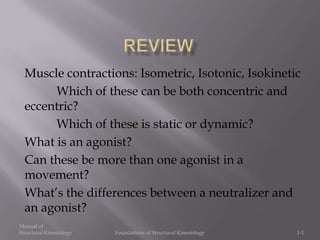
Week 2 pp
- 1. Manual of Structural Kinesiology Foundations of Structural Kinesiology 1-1 Muscle contractions: Isometric, Isotonic, Isokinetic Which of these can be both concentric and eccentric? Which of these is static or dynamic? What is an agonist? Can these be more than one agonist in a movement? What’s the differences between a neutralizer and an agonist?
- 2. Manual of Structural Kinesiology Foundations of Structural Kinesiology 1-2 What is the difference between a synergist and an agonist? When the ant. and post. deltoids counteract one another’s movement to allow abduction are they helping synergists or neutralizers? What are the four properties of a skeletal muscle? How does elasticity differ from plasticity?
- 3. Anterior Distal Hallucis Posterior Proximal Pollicis Superior Lateral Inversion Inferior Medial Eversion Deep Prone Radial Deviation Superficial Supine Ulnar Deviation Pronate Plantar Circumduction Supinate Dorsal Elevation Dorsiflexion Depression Plantarflexion Manual of Structural Kinesiology Foundations of Structural Kinesiology 1-3
- 4. Synarthrosis – No movement Amphiarthrosis – Little Movement Diarthrosis – Free movement
- 5. Synarthrosis – No movement (three structural categories) 1. Fibrous: Sutures and gomphosis 2. Cartilagenous: Synchondrosis (cartialge plate)
- 6. Amphiarthrosis – Little movement Fibrous: Syndesmosis (ligamentous connection) Cartilagenous: Symphesis (fibrocartilage)
- 7. Amphiarthrosis – Little movement Fibrous: Syndesmosis (ligamentous connection) Cartilagenous: Symphesis (fibrocartilage)
- 8. Diarthrosis – Freely moveable Synovial: surounded by joint capsule, contains synovial fluid Monaxial Biaxial Triaxial
- 9. Plane/gliding joints: flat or slightly curved faces. Ligaments prevent much movement Hinge joint: Monaxial Pivot joint: only rotation Condylar joints: oval articular surface sits in a depression. Biaxial
- 10. Saddle joint: concave articular surface connects to a convex surface. Allows extensive angular motion. Biaxial. Ball and socket: round head sits in a cup-like depression. Allows for circumduction. Triaxial.
- 11. Connective Tissue of Muscle Epimysium: Dense connective tissue surrounding the entire muscle. Converges to become the tendon. Perimysium: Collagen and elastin with blood vessels and nerves. Surrounds the fascicles (bundles of muscle fibers) and separates each fascicle.
- 13. Connective Tissue of Muscle Con’t. Endomysium: Surrounds each muscle fiber and binds it to its neighbor. Satellite cells are found between the endomysium and the sarcolemma.
- 14. Muscle fiber is a myocyte or muscle cell. Has a plasma membrane with tubes Contains organelles especially extensive SR Multiple nuclei Contains several protiens such as actin, myosin and titin May or may not have extensive mitochondria Contains many sarcomeres in series. Isozyme of ATPase influences fiber type
- 15. Sliding Filament Theory 1. Action potential 2. Release of Ach into the synaptic junction 3. Depolarization across the sarcolemma and into the T tubules 4. Release of Ca from the SR 5. Ca binding onto Troponin 6. Release of tropomyosin from myosin binding sites located on actin 7. The energized yosin (from ATP hydrolysis) attaches to actin and pulls actin 8. ATP attaches to myosin and myosin releases from actin causing ATP hydrolysis and thus energizing the myosin head
- 16. http://www.bing.com/videos/search?q=sliding+filament+theory+a nimation&view=detail&mid=0B856D6FA538FDD89AA70B856D6FA 538FDD89AA7&first=0&FORM=NVPFVR&qpvt=sliding+filament+t heory+animation Number of cross-bridges attached to actin at any one time dictates force production.
- 19. Calcium Release – Motor Unit Recruitment – Increased number of active motor units Preloading Cross sectional area Shortening velocity of a muscle –
- 20. Angle of pennation: Length-tension relationship Stretch-shortening cycle Muscle fiber type -
- 21. MSF GTO –
- 22. Muscles (force) cause movement of bones (levers) around a fulcrum or center of rotation. Resistive force can be overcome if the muscle force is greater than the resistive force. First class lever: Muscle force and resistive force act on opposite sides of the fulcrum. Second class lever: Muscle force and resistive force act on the same side of the fulcrum. (Or resistance is between the axis and the force) However, moment arm is longer than resistance arm. Due to the mechanical advantage of the MA the MF overcomes the RF. Less MF is needed to overcome the resistance. Third class lever: Muscle force and resistive force act on the same side of the fulcrum. However, the MA of the MF is smaller than the MA of the RF and ones loses mechanical advantage. Greater muscle force is needed to overcome the resistance. You must exert more energy.
- 27. OKC: Free movement of the terminal joint CKC: Terminal joint meets with considerable resistance that inhibits or restrains free motion
Notas del editor
- Excitability, Contractility, Extensibility (ability to contract even when stretched), elasticity
- Ends of clavicals, between carpals and tarsals, between articular facets. Pivot: between atlas and axis around the dens Condyl: phalange/metacarpal/tarsal
